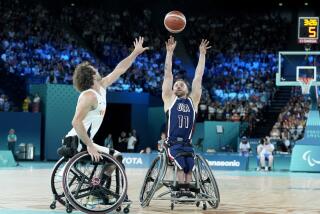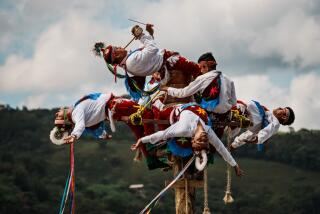RECREATION / PARA-GLIDING : Fledgling Sport May Become a Flying Hit for ‘90s
On a recent business trip to Europe, partners Mike Meier and Steve Pearson did lots of strenuous hiking high in the Austrian Alps. But, thanks to the product they were researching, their trips down from the mountaintops were always easy and exhilarating.
Meier and Pearson simply deployed the brightly colored para-gliders they carried in packs on their backs and--after soaring around in rising hot air for a while--flew down to the valley, where their hosts rewarded them with steaming bratwursts and foaming steins of beer.
“Para-gliding is the coming thing,” Pearson says, “for soaring pilots and alpine hikers alike.”
The fledgling sport combines the technology of sky-diving with the soul of hang gliding. The para-gliders themselves are highly specialized adaptations of sky-diving’s “ram-air” or “square” parachutes--the kind that fly like airfoils rather than simply descend through the air. But because they are designed to be deployed from the ground rather than the air, para-gliders are functionally more similar to hang-gliders.
Most adventure sports enthusiasts agree that para-gliding is destined to become the air sport of the ‘90s. And, as Meier and Pearson and other local para-gliding devotees are quick to point out, the new sport has the potential to develop into the safest, most convenient form of sky trekking ever invented by man.
But if the poor safety record of 80,000 European para-glider pilots is an indication, it could also prove to be the most dangerous.
“The safety record in Europe (where the sport has caught on big in the last five years) hasn’t been good,” admits Meier of Tustin. “The problem is that launch-and-landing technique is too easy to learn. Tens of thousands of Europeans are launching into weather conditions that are too dangerous for their level of ability.
“After learning the basics, they don’t invest the time and discipline necessary to develop the judgment and airmanship it takes to survive any sport that puts you in the air.”
The history of para-gliding in Europe, it seems, is a classic example of the old saying: “A little knowledge is a dangerous thing.”
Meier, Pearson and two other partners own Wills Wing Inc., a Santa Ana-based manufacturer/exporter of hang-gliding equipment. They hope to cash in on the enormous potential of para-gliding by getting in on the ground floor. Based on Meier’s and Pearson’s research, Wills Wing has recently decided to import para-gliding equipment from Europe. The company also plans to actively develop a national dealer/instructor network.
That’s good news for those who hope the lessons learned in Europe won’t go unheeded by U.S. para-gliding enthusiasts. For 10 years, Wills Wing has led the push for mandatory testing of aircraft and the development of safe techniques and attitudes in the training of pilots and instructors.
Locally, Meier and Pearson have been enjoying their combined business venture and recreational pursuit in the same mountains they have used for hang gliding in the last 15 years. The Crestline and Marshall mountains above San Bernardino offer good para-gliding in the right conditions. Soboba Mountain outside Hemet is even better because it is steep enough to accommodate the limited glide performance of para-gliders over a wider range of wind conditions. Other sites include Kagel Mountain in Los Angeles and the Torrey Pines coastal cliffs in San Diego. There are no legal para-gliding sites in Orange County.
There is an uneasy truce between the increasing numbers of para-glider pilots and the established core of hang-glider pilots. Because the two groups must share the same launch and landing zones--and because these areas are always subject to closure if a rash of accidents occur--hang-glider pilots are concerned that a sudden influx of wet-behind-the-ears para-glider pilots will jeopardize their few precious sites.
Meier is optimistic that hang-glider pilots will accept what he called their para-gliding “sky brothers” once they demonstrate the capacity to treat flying and flying sites with care and respect.
“If hang-glider pilots don’t accept para-glider pilots, para-glider pilots will either go to outlaw sites or totally ignore the advice of the more experienced hang-glider pilots,” Meier says. “Either way, there will be more accidents and more clashes with the authorities, and that hurts both groups.”
Both Meier and Pearson say there are three good reasons to believe that U.S. para-gliding will avoid the poor safety record of Europe. “First, we won’t have to repeat the technological evolution of para-glider design over here,” Meier says. “We have safe products to begin with, so we can concern ourselves with making sure the cultural evolution of American para-gliding proceeds along safe line.”
Meier also points to the lessons of history: “We have the record of para-gliding in Europe, and we have the record of hang gliding over here. If we take the good and avoid the bad from both records, we should be all right.”
Finally, Meier says, flying organizations are much stronger in America, and launch sites are much more likely to be regulated. There are no certified para-gliding schools in Orange County. But Fred Lawley of Accelerated Flight Systems in Solana Beach is highly recommended by Meier and Pearson. Lawley, who is certified by the American Paragliding Assn. (APA), offers one day of instruction for $99 and four days for $299. Call (619) 481-7400 for details.
For a local contact, call Dan Skadal at Hang Flight Systems (714) 542-7444. Though Skadal does not yet offer para-gliding lessons, he is the local distributor for Wills Wing equipment. He will be happy to steer you in the right direction if you want to talk about para-gliding or observe local para-glider pilots in action.
More to Read
Sign up for The Wild
We’ll help you find the best places to hike, bike and run, as well as the perfect silent spots for meditation and yoga.
You may occasionally receive promotional content from the Los Angeles Times.






